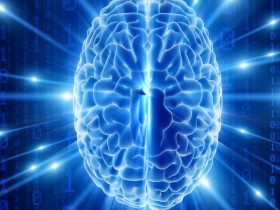I commute long distance. On Monday’s flight, I read two interesting articles on the human brain.
The first was in Monday’s New York Times. Researchers developed technology you control using thought. You put on a headset with virtual reality goggles and sensors that read brain waves, and move virtual objects. The article said researchers “want to build ways of performing nearly any computing task with the mind.” That, I thought, would be totally cool! How advanced!
Then I thought, wait a minute. Much more advanced technology already exists. With your brain, you can control, to an astonishing degree, each of over 600 skeletal muscles in your body. You can perform coordinated feats, like standing upright. (It’s not so easy; it took you about a year to get it right.) With your brain, you can access memory banks of your life and what you have learned. The sophistication of the human brain is dazzling. I love watching and hearing concert pianists play impossibly difficult and breathtakingly beautiful pieces from memory. My college roommate, a chess grandmaster at 13, could and still can crush me in chess without ever looking at the chess board. He visualizes the entire board and all possible moves in his head.
Next I picked up the September issue of Acts and Facts. (It is one of my favorite magazines, and you can get a free subscription by going to this page: http://www.icr.org/icr-magazines ) Dr. Jeffrey Tompkins authored an article entitled: “The Human Brain is ‘Beyond Belief’.” The article reviews recent brain research, and cites 15 scientific papers. Highlights:
- An average healthy human brain contains some 200 billion nerve cells connected to one another through hundreds of trillions of synapses. (About as many cells as stars in our galaxy, and synapses as stars in a thousand galaxies.)
- A single human brain has more information processing units than all the computers, routers, and Internet connections on Earth.
- The neural units in our brain are perfectly placed to minimize “connection costs” among components.
- The brain’s memory capacity is “at least” a petabyte, in the same ballpark as the entire World Wide Web.
- The brain is amazingly energy efficient; human circuits of similar complexity would require at least 1,000 times more energy.
- The cells of the brain communicate with light as well as electrical impulses.
- The brain is a quantum computer.
- The brain creates complex structures to solve problems.
That last bullet is a reference to a June 2017 paper in the Journal of Computational Neuroscience. (Not a journal I’m recommending, but go knock yourself out.) Researchers found our brains build fantastic structures, with fantastic geometries, to solve problems. Here’s one of the researchers:
The neurons in the network react to stimuli in an extremely organized manner. …. We found a world we never imagined. There are tens of millions of these objects even in a small speck of the brain, up through seven dimensions. In some networks, we even found structures with up to eleven dimensions.
The mathematics of this article, with concepts from Algebraic Geometry (yes I took that course in college but don’t ask me any questions) are beyond belief. Not much I understood. I will just note that when the researcher refers to “dimensions,” he is really talking about degrees of connectivity. So when seven neurons create a structure where they are each connected to each other, he is calling that a seven dimensional structure.
When it comes to the architecture and technology of the human brain, we are like primitives with stone tools trying to understand a spaceship. As hard as we try, and thousands of very smart people are trying very hard, we are only a vague idea of how the brain works. We think we are smart to say the frontal cortex performs executive functions. That’s like the primitive saying the back of the spaceship has something to do with movement. Exactly how is it your brain processes signals from your eyes to recognize these letters and words, to make sense of them, and to ponder their meaning? Tell me, if you can, how that works.
So new research says the brain builds structures to solve problems? How could any rational person believe the human brain “evolved” from a Darwinian process of keeping the best errors? That is preposterously absurd, totally idiotic, and without a fig leaf shred of believability! No way ultra technology arose by chance. I would also point you to page 165 of Counting To God, where I note that the human brain has at least 54 “orphan” brain genes, 54 sections of DNA code that no other species has that build the fantastic nanotechnology we use to think and reason.
I can be sarcastic. Maybe next time someone tells me belief in God is not scientific, I’ll respond — “so you’re one of those ‘scientific’ people who believe the human brain arose by chance?”
Thanks for reading. Please tell others, and spread the good news of true science. Together we can change the world, and free it from this pathetically depressing Atheist paradigm of a meaningless universe. God is real. Govern yourself accordingly.


















Leave a Reply